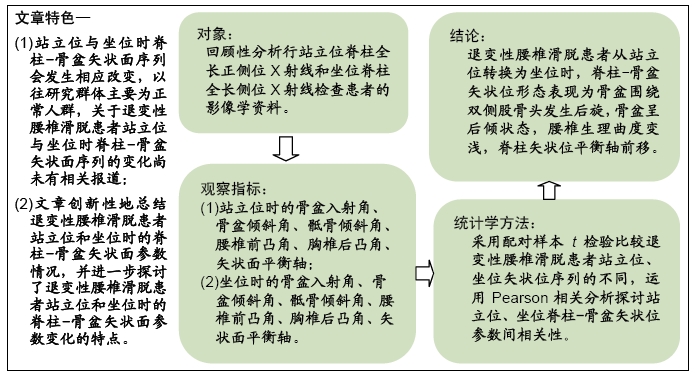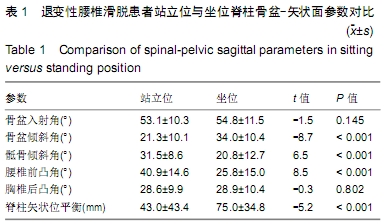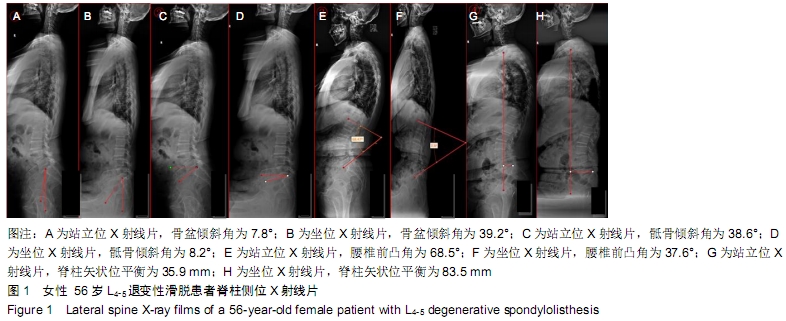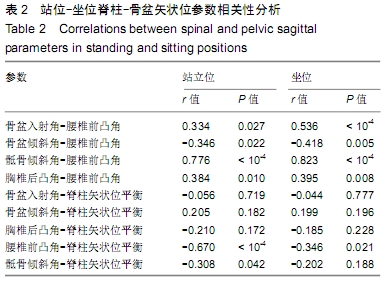中国组织工程研究 ›› 2020, Vol. 24 ›› Issue (24): 3857-3861.doi: 10.3969/j.issn.2095-4344.2706
• 骨与关节图像与影像 bone and joint imaging • 上一篇 下一篇
退变性腰椎滑脱患者坐-立位脊柱-骨盆矢状面序列的影像变化
刘 阳,徐宝山,许海委,黎 宁,姜洪丰,王 涛,刘 越
- 天津市天津医院微创脊柱外科,天津市 300211
Imaging changes in spinal-pelvic sagittal alignment in sitting and standing positions in degenerative lumbar spondylolisthesis patients
Liu Yang, Xu Baoshan, Xu Haiwei, Li Ning, Jiang Hongfeng, Wang Tao, Liu Yue
- Department of Minimally Invasive Spine Surgery, Tianjin Hospital, Tianjin 300211, China
摘要:

文题释义:
退变性腰椎滑脱:是一类常见的老年退变性疾病,影像学上表现为在椎弓完整的情况下,一个椎体相对于另一个椎体向前或向后移位,好发于L4-5节段,临床上多表现为腰椎管狭窄症状,行走后症状加重,休息时减轻,保守治疗效果不佳时通常需要手术治疗。
脊柱-骨盆矢状面序列:由脊柱和骨盆共同构成,在正常生理状态下,脊柱在矢状面呈“S”形,上承头颅,下连骨盆,有颈、胸、腰、骶4个生理弯曲,对于维持脊柱平衡具有重要意义。脊柱-骨盆矢状面序列的异常与退变性腰椎滑脱等疾病发生、发展相关,同时脊柱-骨盆矢状面序列受姿势的影响,当姿势变化时脊柱-骨盆矢状面序列也会发生相应改变。
背景:脊柱-骨盆矢状面序列对于退变性腰椎滑脱的诊治十分重要,但是目前关于退变性腰椎滑脱患者脊柱-骨盆矢状面序列的研究局限在站立位体位,坐位下的脊柱-骨盆矢状面序列未见相关报道。
目的:分析退变性腰椎滑脱患者坐-立位脊柱-骨盆矢状位序列的影像学资料,探究退变性腰椎滑脱患者脊柱-骨盆矢状位序列从站立位到坐位的变化特点。
方法:纳入2019年3至9月天津市天津医院收治的44例退变性腰椎滑脱患者,其中男12例,女32例,年龄50-84岁,所有患者均拍摄站立位全脊柱X射线片和坐位全脊柱X射线片,通过院内影像归档与通信系统测量每例患者的骨盆入射角、骨盆倾斜角、骶骨倾斜角、腰椎前凸角、胸椎后凸角、矢状面平衡轴等参数,比较退变性腰椎滑脱患者站立位、坐位矢状位序列的不同,运用Pearson相关分析探讨站立位、坐位脊柱-骨盆矢状位参数间相关性。试验获得天津市天津医院伦理委员会批准。
结果与结论:①由站立位转变为坐位时,44例退变性腰椎滑脱患者的骨盆倾斜角增大[(21.3±10.1)°,(34.0±10.4)°,P < 0.001]、骶骨倾斜角减小[(31.5±8.6)°,(20.8±12.7)°,P < 0.001]、腰椎前凸角减小[(40.9±14.6)°,(25.8±15.0)°,P < 0.001]、矢状面平衡轴增大[(43.0±43.4),(75.0±34.8)mm,P < 0.001],骨盆入射角与胸椎后凸角无明显改变(P > 0.05);②无论站位还是坐位,腰椎前凸角与其他5项参数均具有相关性(P < 0.05);由站位转换为坐位后,骶骨倾斜角与矢状位平衡参数矢状面平衡轴的相关性消失(P > 0.05),腰椎前凸角与矢状面平衡轴的相关性仍然存在(P < 0.05);③结果表明退变性腰椎滑脱患者从站位转换为坐位时,脊柱-骨盆矢状位形态表现为骨盆围绕双侧股骨头发生后旋,骨盆呈后倾状态,腰椎生理曲度变浅,脊柱矢状位平衡轴前移。
ORCID: 0000-0002-9690-3188(刘阳)
中国组织工程研究杂志出版内容重点:人工关节;骨植入物;脊柱;骨折;内固定;数字化骨科;组织工程
中图分类号:



